Lake Whitney is an important feature of North Central Texas, serving as a habitat for local wildlife and providing water and recreation to its lakeside residents and the surrounding towns and municipalities. It is an artificial reservoir impounded by the Whitney Dam.
In this article, we’ll look at the basic characteristics of Lake Whitney, including its size, location, and depth. We’ll also look at the history of its formation, its historic water levels, and the types of recreation activities that the lake is popular for.
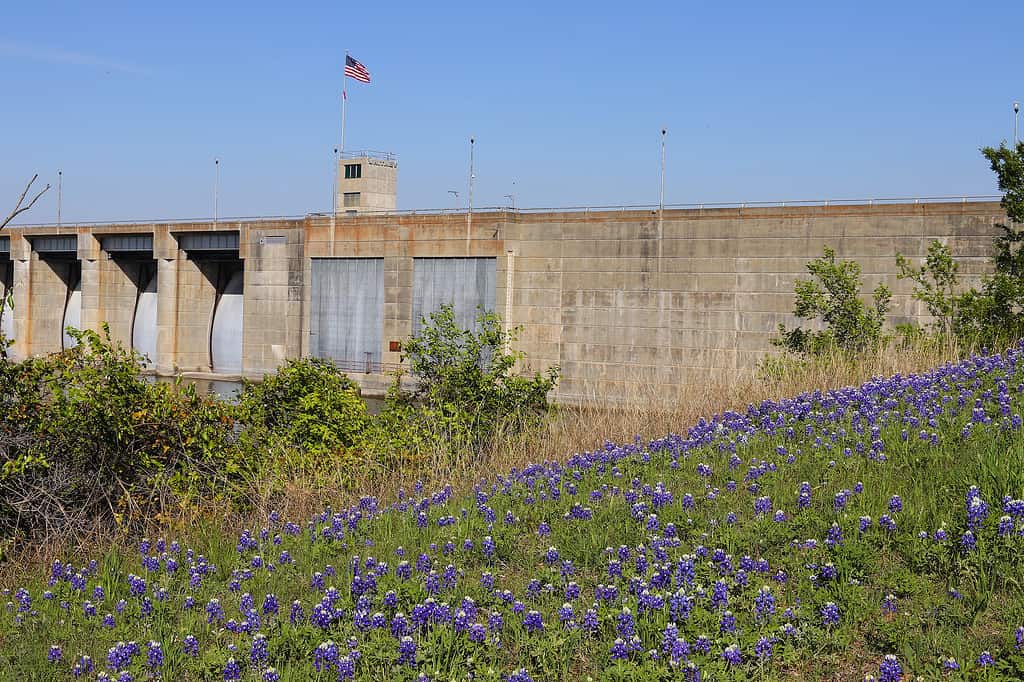
Aside from the massive dam that impounds the Brazos River, Lake Whitney is famous for its bluebonnets which grow plentifully along its banks.
©Hundley_Photography/iStock via Getty Images
Location
Lake Whitney is a flood control reservoir that sits along the Brazos River in the eastern part of Central Texas. It is about 30 miles to the northwest of Waco and about 65 miles southwest of the Fort Worth area. Since the early 1950s, its position along the Brazos has allowed the United States Army Corps of Engineers to monitor and mitigate floodwater downstream. The lake is also a part of the Texas Lakes Trail region which showcases historic locations across 31 counties in North Central Texas.
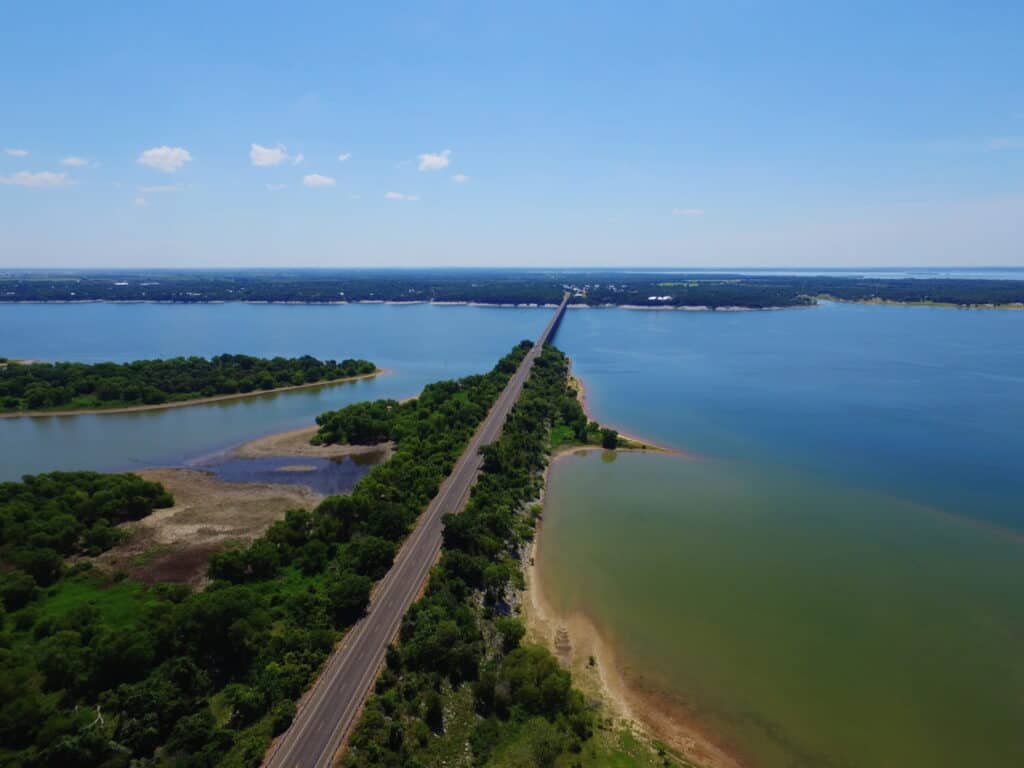
The Lake Whitney Bridge closes the gap between two nearby towns and shortens the distance between the State Park and day-use areas on the opposing banks.
©Hundley Photography/Shutterstock.com
Closer together along the lake’s edge, the Lake Whitney Bridge connects the towns of Whitney and Lakeside Village. The bridge effectively splits the lake’s perimeter in half, saving drivers time and giving them stunning views from above the water. By joining the banks, it also gives visitors better access to the lake’s many gorgeous public parks.
History
Humans lived in the area surrounding Lake Whitney long before the lake itself ever existed. Archaeological evidence shows that prehistoric humans occupied the area as early as 12,000 years ago. Important rock shelters that now sit beneath the lake also show more recent human habitation. For about 250 years, between 550AD and 800AD, people living during the Austin Phase occupied an area along the Brazos River in Hill County. Several hundred years later, between 1300AD and 1550AD, peoples of the Toyah Phase inhabited the same area. This phase of human habitation is considered the last prehistoric phase before the advent of modern Native American cultures and the arrival of Europeans in the 16th century.
Later on, in the early 1800s, Native American peoples displaced by the Europeans moved into the area. Groups of Comanche and Taovaya migrated to the area in the early 1820s, with several Caddo and Hainai people following soon after. By the 1850s, colonizers claimed the site of a Hainai community and forced them further upstream. Ironically, they adopted the name of their chief, Towash, as the name of their new settlement.
In the 1930s, the U.S. Army Corps of Engineers began planning the Whitney Lock and Dam to help mitigate flooding along the Brazos River. By 1941, Congress had approved the plans for the reservoir and powerhouse. Soon after, however, due to U.S. involvement in World War II, the construction of the dam was halted. Construction resumed in 1951 and concluded just two years later, creating an artificial reservoir that would swallow massive tracts of land.

The impoundment of the Brazos by the Whitney Dam caused the once free-flowing river to engulf the settlements that once existed along its banks.
©U.S. Army Corps of Engineers / Public Domain – Original
Size
The artificial Lake Whitney covers more than 23,500 acres of land behind its lock and dam. That’s about 37 square miles. It needs to be this large to control the contributions from the massive watershed that feeds it. The total drainage area measures more than 27,000 square miles, feeding the lake itself as well as the Brazos River and its tributaries.
Lake Whitney’s massive surface area means that it has an equally impressive perimeter. The lake creates about 225 miles of shoreline which serves as an important breeding habitat for many of its inhabitants. It also provides plenty of room for recreational activities like swimming and fishing, as well as places to launch watercraft.

Lake Whitney’s long, winding banks provide valuable habitat for local wildlife and great access to recreational activities.
©Greens and Blues/Shutterstock.com
Depth
Though the water volume behind the Whitney Dam fluctuates with rain and drought, the lake’s maximum depth is 108 feet. There are various planned “layers” within the depth of the lake. The bottommost layer and subsequently the least water volume provides flow to the dam’s powerhouse. If all else fails during unprecedented drought conditions, power generation is the last thing to cease.
The middle section of the reservoir, comprising about 230,000 acre-feet (about 75 billion gallons) of water, makes up the lake’s conservation pool. This water is dedicated solely to storage and is used to serve the recreational, residential, municipal, and industrial needs of the surrounding area. In short, it is a reserve water supply. If towns and municipalities downstream from Lake Whitney are experiencing a water shortage, the Brazos River Authority and Corps of Engineers can release some of the lake’s reserves into the river.
Above the level of the conservation pool is the flood pool. This section takes up the remaining 38 vertical feet of the reservoir’s depth. It is there as an emergency zone, allowing the lake to swell many times its size in the event of massive flooding. In an extreme scenario, the dam can retain about 1,600,000 acre-feet of water. That’s over 521 billion gallons!

The Whitney Dam measures a whopping 166 feet in height and can retain more than half a trillion gallons of water at its maximum capacity!
©Hundley_Photography/iStock via Getty Images
Water Level
The average water level in Lake Whitney is relatively stable, fluctuating between 4 and 8 feet annually. Today, its water level hovers around 75% of the total capacity of the conservation pool. Since the construction of the dam, the lake’s water level has never dropped below the conservation pool’s boundaries. It has, however, risen above them.
In 1957, prolonged, heavy rains caused the lake’s water level to rise within a foot of the dam’s maximum flood capacity. At this level, the lake surface sat 570.25 feet above sea level — 37.25 feet above the top of the conservation pool’s elevation. Later, in 1990 influx of water would drive the lake’s surface elevation to nearly 565 feet, the second highest on record.
Levels have surged high above the conservation pool several times in recent years. In 2016, the pool’s surface elevation rose to 561.33 feet, just short of the third-highest elevation on record. A few years later, in 2019, the lake surface surged about 22 feet above the conservation pool, reaching an elevation of 555 feet.
Throughout most of 2022 and 2023, the lake has remained at about 75% of the conservation pool capacity at 525 feet above sea level. In recent years, there have been concerns that some important dams, like the Hoover Dam and Glen Canyon Dam, could experience a water level known as a “dead pool”. This is when the water level in a reservoir drops too low to exit through the dam’s gates, entirely cutting off the water supply downstream. As of right now, there does not appear to be imminent danger of Lake Whitney reaching this state.
Fishing
Each year, more than 2 million people use Lake Whitney’s waters for recreational purposes, including fishing. Residents and visitors alike widely regard fishing on the lake as one of the most important aspects of their quality of life.
Many species of fish call the lake their home, most of which are popular among anglers. Below, we’ll talk about the most sought-after groups of fish that reside in Lake Whitney
Bass
A variety of bass species live in the lake. Among them are the familiar smallmouth (Micropterus dolomieu) and largemouth (Micropterus salmoides) basses that top the state’s list of most sought-after fish. There are countless angling clubs statewide that arrange fishing trips and organize bass conservation efforts. While they are commonly referred to as bass, both species belong to the sunfish family and are more closely related to bluegill and warmouth than to true basses.
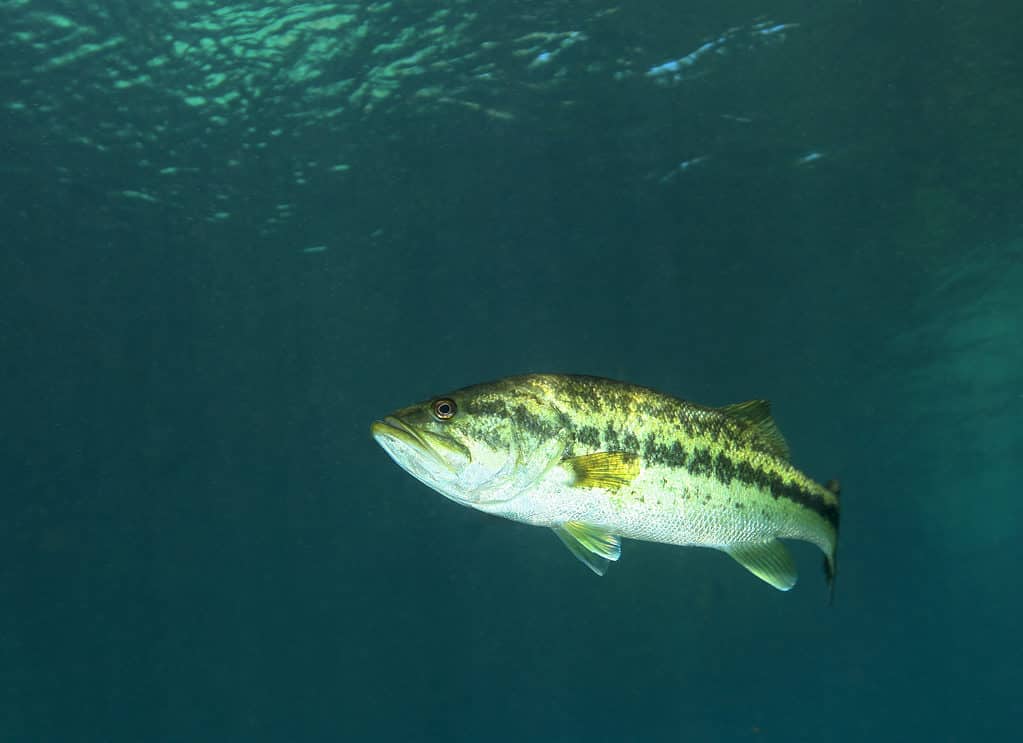
Lake Whitney is home to innumerable largemouth and smallmouth basses. The pair tops the list of the most sought-after game fish in all of Texas.
©iStock.com/mpwoodib
There are also species of true bass that inhabit Lake Whitney’s waters. One, the striped bass (Morone saxatilis) is a coastal species that is not native to the Brazos River or its tributaries. Because of its general popularity as a game fish, the Texas Wildlife Department periodically releases them into the lake. They do the same with the white bass (Morone chrysops), which is native to the state’s Red River drainage area.
Catfishes
Second only to the basses, catfishes are very popular targets of Lake Whitney’s anglers. The lake supports populations of blue catfish (Ictalurus furcatus), channel catfish (Ictalurus punctatus), and flathead catfish (Pylodictis olivaris), all of which enjoy the deep depths and murky water.
The blue catfish is the largest of the three, with record specimens reaching more than 115 pounds! During the summer, they primarily inhabit the areas of the lake closer to the inlet of the Brazos, where water is cooler and faster-moving. In the winter, they migrate further into the depths.

Crappie
Both black crappie (Pomoxis nigromaculatus) and white crappie (Pomoxis annularis) swim the waters of Lake Whitney. Together, they represent the third most sought-after group of fish by Texas anglers. Both species build underwater nests in the springtime when water temperatures are between 60 and 70 degrees Fahrenheit. Fry hatch from their eggs within a few days and, after reaching their fingerling stage, begin to swim in schools. Within the first year, fish may grow to between 3 and 5 inches in length. By their second year, they are often more than 7 inches long. Large schools can usually be found in the middle of the lake, far from the shoreline. Fish may also group up around submerged cover like fallen trees or floating docks.
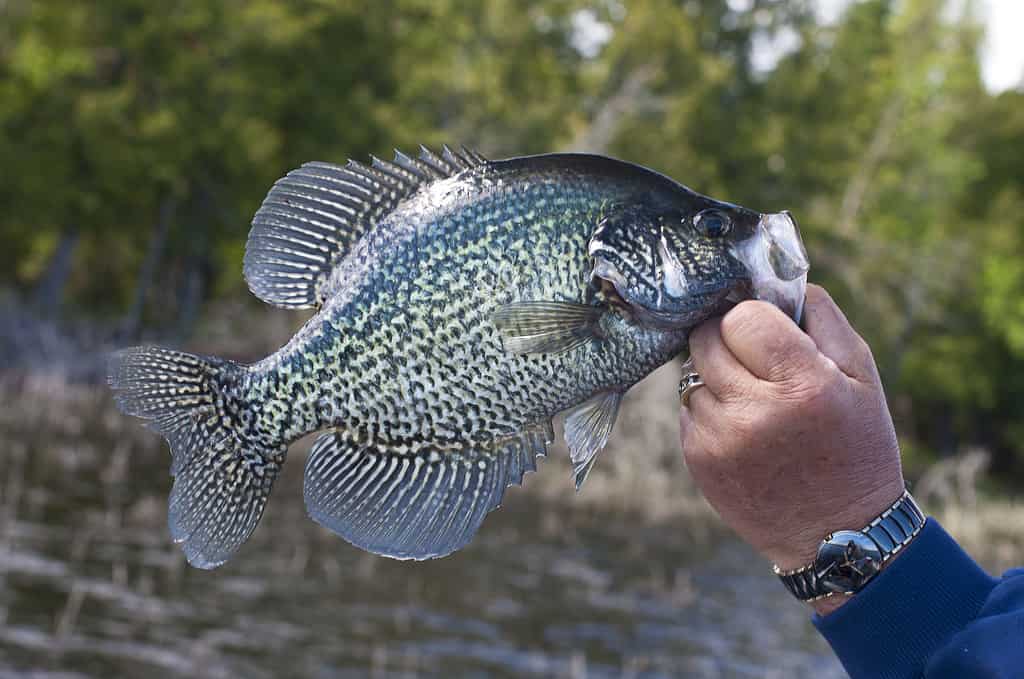
Both white and black crappie are among the residents of Lake Whitney most targeted by Texas anglers.
©SteveOehlenschlager/iStock / Getty Images Plus via Getty Images
Golden Algae and Fish Kills
In areas where water is slightly saline, as in the Brazos and Lake Whitney, toxic golden algae (Prymnesium parvum) can become a real problem. The species is widespread, occurring in waters across the globe. They appear in freshwater lakes and rivers but prefer environments with particularly hard or saline water.

Golden algae blooms can have a huge impact on a lake’s aquatic life, frequently resulting in large-scale fish kills.
©Mike Hooper, USGS / Public Domain – Original
In small numbers, the algae are generally innocuous. However, if conditions are right, they may enter periods of extreme population growth, called blooms. During these periods, the rapid buildup of toxins in the water can severely kill or injure gilled animals like fish, mollusks, young amphibians, and gill-breathing insect larvae like those of dragonflies. Large algal blooms can last for weeks at a time or even months. Because blooms are suspended in the water, they may migrate across the lake in the direction of winds and currents.
While blue-green algal blooms can be deadly to humans and pets, the effects of golden algal blooms appear limited to aquatic animals. However, experts still recommend that people avoid consuming or interacting with fish that appear to be sick or dying, especially during a bloom. If you’re planning a fishing trip, you should keep up-to-date with the Parks and Wildlife Department’s status report on current algal blooms.
Boating and Other Activities
Where there’s lake fishing, there’s usually boating and Lake Whitney is no exception. There are 12 major public parks situated along the lake’s shoreline, most of which have boat ramps and courtesy docks. Two locations on opposite sides of the lake, Morgan Lakeside and Lofer’s Bend have refueling stations.
The U.S. Army Corps of Engineers operates and maintains these parks and while many of the amenities are free to the public, some of them have marginal fees or require annual passes to use. For example, some parks require entrance fees, while others charge only for access to the boat launch. Maps of the lake and the locations of the various parks are available online and in person.
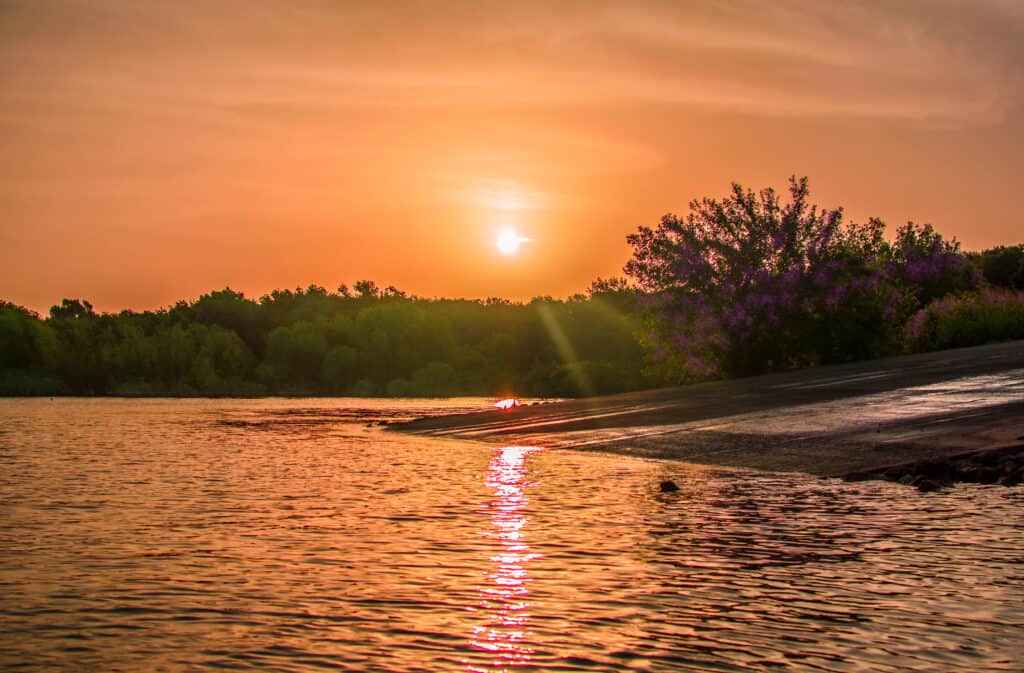
Watercraft are common at Lake Whitney, and there are numerous locations, both public and private, to launch boats, canoes, and kayaks.
©Pierre Rebollar/Shutterstock.com
Camping
In addition to fishing and boating, many people visit Lake Whitney to set up camp and enjoy the outdoors. Various private and public campgrounds offer both tent camping and RV parking.
Lake Whitney State Park alone offers nearly 150 developed campsites with various levels of amenities. Horseshoe Campground, for example, is a great spot for RV campers. It offers more than 40 sites with water, electric, and direct sewer hookups. If you’re looking for a less crowded camping experience that puts you close to the lakeside, the park’s Blue Bird Loop is a great choice. Nine of the 12 campsites along the loop sit very close to the water’s edge, providing easy access and wonderful lakeside sunsets. Sites at these campgrounds range from $20 to $24 per night with discounted weekly rates during the off-season. Cheaper sites with only water hookups are also available, costing $14 per night.
If you plan on camping at the lake, be sure to check campsite availability ahead of time! If the weather is good, the best sites can fill up quickly. Those who are planning on traveling from out of town should pay close attention to the weather. Remember that although there is water nearby to cool off, you should plan for summer temperatures over 100 degrees Fahrenheit!
Thank you for reading! Have some feedback for us? Contact the AZ Animals editorial team.








